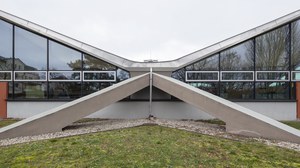Teaching Concept
The Chair of Structural Design is dedicated to convey a holistic design approach and to achieve a close connection between structural design and architectural ideas. An important sub-area are methods of graphic statics, which enable an intuitive grasp of the flow of forces. The interlocking of both disciplines is made evident by an in-depth analysis of outstanding buildings of architectural and building history from different cultures and epochs.
 © Wilfried Dechau
© Wilfried Dechau
Courses and Modules offered by the Chair of Structural Design
„Elementary Courses Structural Design I-IV“
The elementary courses Structural Design I-IV introduce the principles of structural design and analysis and form the basis for advanced studies. Prospective architects will learn the essentials of structural behaviour and construction materials. This is the prerequisite for a solid understanding of forces and their reactions to built structures, so that students will be able to develop realistic, statically and economically effective and aesthetically sophisticated solutions in their own architectural designs.
„Selected chapters of structural design"
Building on the foundation courses in the basic study period, the module "Selected chapters of structural design" in the advanced study period deepens various special areas of structural design. Lectures on lightweight structures, innovative constructions and progressive building technologies provide a well-founded constructive understanding, aimed at providing guidance for students' own design work. The topics vary over the semesters and provide an in-depth insight into the various fields of structural design. The lessons are rounded off by excursions and special guest speakers.
Connecting with real-world practice
The Chair benefits from many years of experience in continuous cooperation with industry partners. We help to solve problems revolving around special and spatial structures, innovative construction materials as well as around of conservation and retrofitting. The curriculum thus focuses on the interface between engineering and architecture.
Partial exams of studio work
Alongside the creative, aesthetic aspects of a design, the constructive details are also an important factor. Our students learn to develop a design approach that considers constructive, technical and economic aspects. This also includes the assessment of the flow of forces, the pre-dimensioning of structural elements and the development of important structural details.

